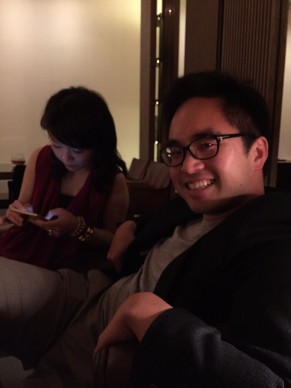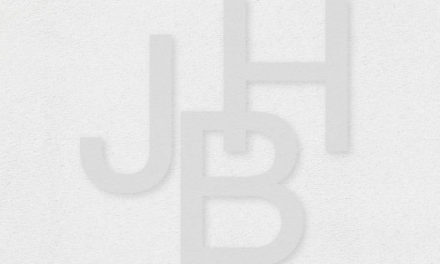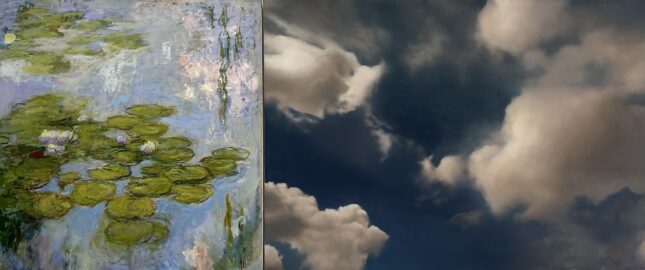
Monet/ Richter
The stuff of dreams
When the superstar of French culture André Malraux (1901-1976) – the former minister with a lyrical turn of phrase – stated in his book “Les voix du silence” (The Voices of Silence) that “the museum is a confrontation of metamorphoses” we can well imagine he was referring to the fact that the artist has the gift of being able to transform a canvas and paint into what is truly the stuff of dreams.
Samuel Keller
We must believe that Samuel Keller, director of the famous Beyeler Foundation in Basel, has fully understood the message by metamorphosizing in turn the concept behind their new exhibition staged in the spaces designed by Renzo Piano, as well as the park (See here an other interview of Samuel Keller). This unprecedented project has been conceived by a collective of artists and curators (1) to be in perpetual evolution.
Summer revolution
Thirty visual artists are taking part in this summer revolution. From the entrance to the foundation we are intrigued by a large greenhouse in the middle of the park. It is the work of Precious Okoyomon (born in 1993), an American artist of Nigerian origin who has created a real garden filled with colourful flowers.
Precious Okoyomon
At the centre of the paradisiacal space sleeps a huge teddy bear, a reference to children’s dreams, according to the artist. But this Garden of Eden is in fact a nightmare that the toddler can’t escape. Precious has carefully chosen plants that are deadly. Heading towards the foundation we are caught in thick banks of fog created by Fujiko Nakaya (born in 1933). The Japanese artist is the first to use mist as a raw material, because it “makes visible things invisible and invisible things visible, like the wind.”
Carsten Holler and Adam Haar
Inside the main building, German artist Carsten Holler (born in 1961), who likes to create experiences with visitors, has collaborated with a specialist from M.I.T., Adam Haar, to produce a bed that enables the person lying in it to actually dream they are flying. It starts moving according to complex calculations. A blinking light hypnotizes you (See here a report about a Carsten Holler show in Lisbon).
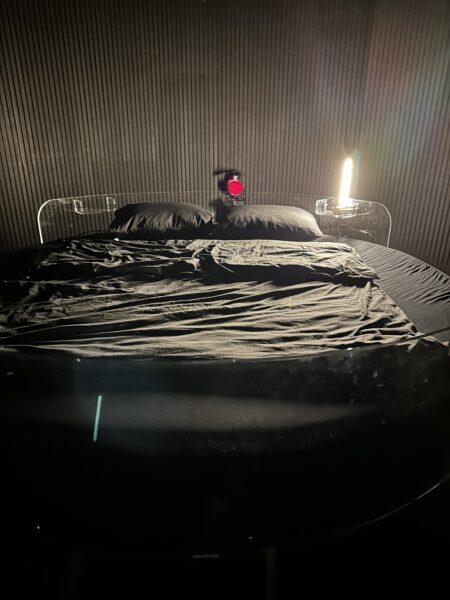
Carsten Holler
This is how you influence the only space humans have that’s still kept private: their dreams. Another way of making your dreams come true in an exhibition that’s definitively 2.0.
Adrian Villar Rojas
The topic of science, in the broader sense, which influences art is also touched on in the work of Argentine artist Adrian Villar-Rojas (born in 1980) (See here an other interview of Adrian Villar Rojas). He’s entitled his two sculptures with a futurist design, “The End of Imagination”.
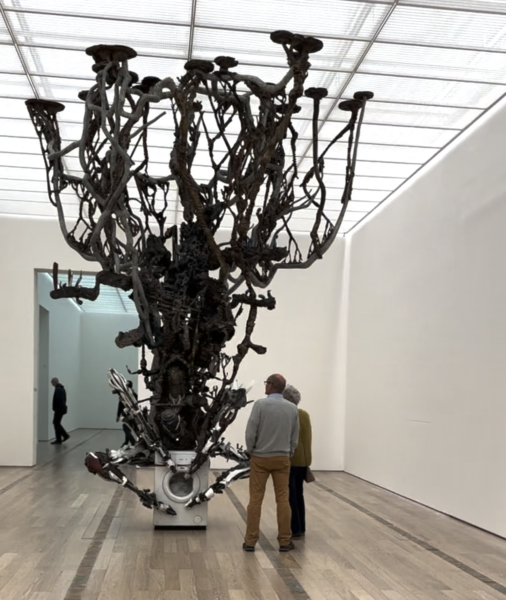
Adrian Villar Rojas
To generate them he developed a system called “The Time Engine” composed of pieces of software that use, among other things, artificial intelligence to create and simulate the effects of time. Above a whirring washing machine there’s a sprawling metallic form, a sort of tree straight out of science fiction made from a mound of scrap metal which seems to project its branches up to the ceiling.
Secrets of the world
And seeking an answer to all the metaphysical questions posed by this unconventional show, the centre of the exhibition space is occupied by a library which, divided into four seasons, presents the secrets of the world, according to Palermo philosopher Federico Campagna.
To appreciate is to support.
To support is to donate.
Support JB Reports by becoming a sustaining Patron with a recurring or a spontaneous donation.
Sublime artworks
Even the sublime “classical” artworks from the permanent collection aren’t spared the general questioning practiced in this exhibition. The layout has been revised in a powerful and very unexpected way by an artist known for rewriting the rules of the art game: Tino Sehgal (born in 1976) ( See here an other interview of Tino Sehgal).
Tino Sehgal
Here, hung side by side according to a seemingly random method, is a painting of a vast sky by Gerhard Richter, and one of the famous Rouen cathedrals by Claude Monet, bathed in bluish late-afternoon light.
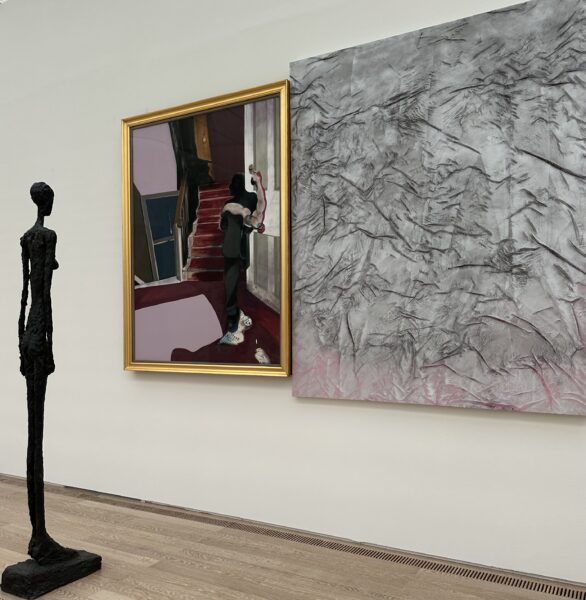
Giacometti/ Bacon
A spindly “Grande femme” by Giacometti dating from 1960 is presented from behind since she is looking at a Francis Bacon canvas, a tribute to his boyfriend who committed suicide, George Dyer, part of a triptych from 1971, in shades of violet.
Warhol/ Rousseau
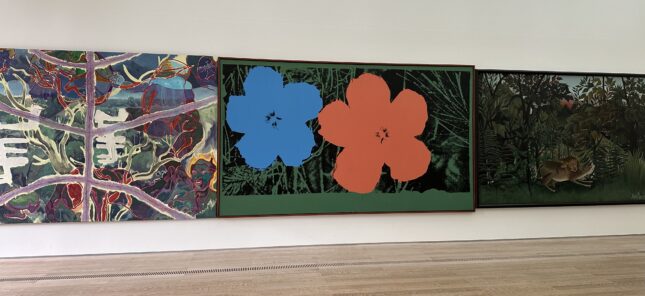
Armitage, Warhol, Rousseau
Enormous Pop Art flowers by Andy Warhol dating from 1965, archetypes of the 20th-century flower, sit alongside an archetype from another time, a painting by Henri Rousseau made around 1905. It depicts, as its title indicates, “The Hungry Lion Throwing Itself on the Antelope”. Rousseau had the idea for the painting while looking through illustrated publications, like Warhol, who was always inspired by photos in magazines.
I feel love

Warhol/Dumas
But suddenly acapella singing draws us towards the final room. A choir is singing, in a lyrical yet rhythmic manner, “I Feel Love” by Donna Summer. It’s a performance developed as a form of optimistic conclusion by Tino Sehgal.

Victor Man
The Beyeler Foundation’s summer exhibition invites us to look differently at artworks that explode with feeling and beauty. All the more reason to spend even more time in this museum.
Until 11 August. www.fondationbeyeler.ch/fr
(1) In addition to Samuel Keller, these are Mouna Mekouar, Isabela Mora, Hans Ulrich Obrist, Precious Okoyomon, Philippe Parreno and Tino Sehgal.
Support independent news on art.
Your contribution : Make a monthly commitment to support JB Reports or a one off contribution as and when you feel like it. Choose the option that suits you best.
Need to cancel a recurring donation? Please go here.
The donation is considered to be a subscription for a fee set by the donor and for a duration also set by the donor.


